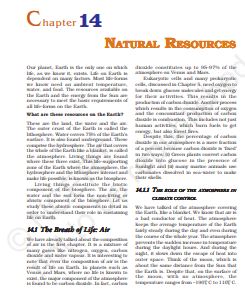‘NCERT Solutions for Class 9 Science Chapter 14‘ PDF Quick download link is given at the bottom of this article. You can see the PDF demo, size of the PDF, page numbers, and direct download Free PDF of ‘Ncert Class 9 Science Chapter 14 Exercise Solution’ using the download button.
NCERT Class 9 Science Textbook Chapter 14 With Answer PDF Free Download

Chapter 14: Natural Resources
Our planet, Earth is the only one on which life, as we know it, exists. Life on Earth is dependent on many factors.
Most life forms we know need ambient temperature, water, and food. The resources available on the Earth and the energy from the Sun are necessary to meet the basic requirements of all life forms on the Earth.
What are these resources on Earth? These are the land, the water, and the air. The outer crust of the Earth is called the lithosphere.
Water covers 75% of the Earth’s surface. It is also found underground. These comprise the hydrosphere.
The air that covers the whole of the Earth like a blanket, is called the atmosphere. Living things are found where these three exist.
This life-supporting zone of the Earth where the atmosphere, the hydrosphere, and the lithosphere interact and make life possible, is known as the biosphere.
Living things constitute the biotic component of the biosphere. The air, the water, and the soil form the non-living or abiotic component of the biosphere.
Let us study these abiotic components in detail in order to understand their role in sustaining life on Earth.
14.1 The Breath of Life: Air The Breath of Life: Air
We have already talked about the composition of air in the first chapter. It is a mixture of many gases like nitrogen, oxygen, carbon dioxide, and water vapor.
It is interesting to note that even the composition of air is the result of life on Earth.
On planets such as Venus and Mars, where no life is known to exist, the major component of the atmosphere is found to be carbon dioxide.
In fact, carbon dioxide constitutes up to 95-97% of the atmosphere on Venus and Mars.
Eukaryotic cells and many prokaryotic cells, discussed in Chapter 5, need oxygen to break down glucose molecules and get energy for their activities.
This results in the production of carbon dioxide. Another process that results in the consumption of oxygen and the concomitant production of carbon dioxide is combustion.
This includes not just human activities, which burn fuels to get energy, but also forest fires.
Despite this, the percentage of carbon dioxide in our atmosphere is a mere fraction of a percent because carbon dioxide is ‘fixed’ in two ways: (i) Green plants convert carbon dioxide into glucose in the presence of Sunlight, and (ii) many marine animals use carbonates dissolved in seawater to make their shells.
14.1.1 The Role of The Atmosphere In Climate Control
We have talked of the atmosphere covering the Earth, like a blanket. We know that air is a bad conductor of heat.
The atmosphere keeps the average temperature of the Earth fairly steady during the day and even during the course of the whole year.
The atmosphere prevents the sudden increase in temperature during the daylight hours. And during the night, it slows down the escape of heat into outer space.
Think of the moon, which is about the same distance from the Sun as the Earth is. Despite that, on the surface of the moon, with no atmosphere, the temperature ranges from –190º C to 110º C.
| Author | NCERT |
| Language | English |
| No. of Pages | 14 |
| PDF Size | 2.8 MB |
| Category | Science |
| Source/Credits | ncert.nic.in |
NCERT Solutions Class 9 Science Chapter 14 Natural Resources
1. How is our atmosphere different from the atmospheres on Venus and Mars?
Ans: Ans:
Earth’s atmosphere is composed of various gases like oxygen, carbon dioxide, nitrogen, and water vapor along with various gases in small quantities, hence making it a balanced composition that is more livable than other planets.
Planets like Venus and Mars have more than 95% of carbon dioxide in the air making the existence of life impossible.
2. How does the atmosphere act as a blanket?
Ans:
⇒ It maintains the consistency in temperature throughout the day making it a comfortable place to stay.
⇒ The ozone in the atmosphere is responsible for maintaining the temperature without letting the harmful ultra-violet ray affect.
3. What causes winds?
Ans:
The uneven heating of the earth’s surface is the main cause of the winds. On being heated more the air raises up and hence low pressure is created.
Hence, the air in high pressure occupies the low-pressure region causing the wind.
4. How are clouds formed?
Ans:
During the daytime in the presence of sunlight water from sources like well, lakes, ponds, sea, river,s and various other sources get evaporated and this water vapor rises up with the hot air.
At a particular height, the air cools and the water vapor condenses to form minute droplets to form clouds.
5. List any three human activities that you think would lead to air pollution.
Ans:
⇒ Burning of fuels like petroleum, kerosene, and coal in the atmosphere
⇒ The smoke released from manufacturing industries
⇒ Smoke from vehicles
Natural Resources NCERT Textbook With Solutions PDF Free Download
